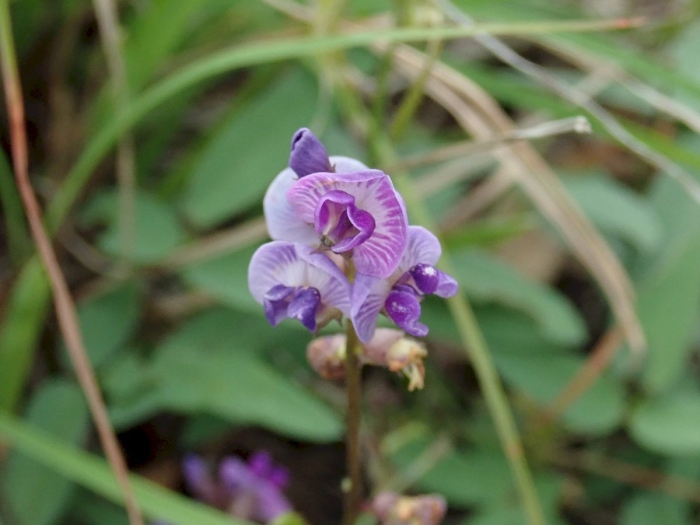Variable Glycine
(Glycine tabacina)
Variable Glycine (Glycine tabacina)
/
/

© coenobita
CC BY 4.0
Image By:
© coenobita
Recorded By:
Copyright:
CC BY 4.0
Copyright Notice:
Photo by: © coenobita | License Type: CC BY 4.0 | License URL: http://creativecommons.org/licenses/by/4.0/ | Uploader: coenobita | Publisher: iNaturalist |












































Estimated Native Range
Summary
Glycine tabacina, commonly known as Variable Glycine, is a perennial herb native to open woodlands and grasslands, as well as riparian areas in Australia, New Caledonia, Tawain, and Southern China. It is characterized by its scrambling habit and slender stems that can reach up to 1 meter in length, either trailing or creeping and often twining. The stems are covered in stiff, straight hairs and emerge from a thickened root system. Variable Glycine is recognized by its leaflet stalks and pea-shaped flowers that vary in color from purple to mauve, blooming profusely from spring to autumn. The flowers are modest in size but can be quite numerous, adding a delicate texture to garden spaces. Once mature, the pods turn black, with seeds inside that are red to brown.
Variable Glycine is valued for its adaptability to various soil types and pH levels, ranging from acidic to alkaline. It is often used in restoration projects due to its nitrogen-fixing ability, which improves soil fertility. In gardens, it can serve as ground cover or be allowed to climb on structures. This plant prefers full sun but can tolerate part shade, and it requires medium amounts of water with well-drained soil. While it is generally low-maintenance, it can be susceptible to root rot in overly wet conditions.CC BY-SA 4.0
Variable Glycine is valued for its adaptability to various soil types and pH levels, ranging from acidic to alkaline. It is often used in restoration projects due to its nitrogen-fixing ability, which improves soil fertility. In gardens, it can serve as ground cover or be allowed to climb on structures. This plant prefers full sun but can tolerate part shade, and it requires medium amounts of water with well-drained soil. While it is generally low-maintenance, it can be susceptible to root rot in overly wet conditions.CC BY-SA 4.0
Plant Description
- Plant Type: Vine
- Height: 0.3-0.5 feet
- Width: 1-2 feet
- Growth Rate: Moderate
- Flower Color: Purple
- Flowering Season: Spring, Summer, Fall
- Leaf Retention: Semi-Deciduous
Growth Requirements
- Sun: Full Sun
- Water: Medium
- Drainage: Slow, Medium, Fast
Common Uses
Edible*Disclaimer: Easyscape's listed plant edibility is for informational use. Always verify the safety and proper identification of any plant before consumption., Low Maintenance
Natural Habitat
native to open woodlands and grasslands, as well as riparian areas in Australia, New Caledonia, Tawain, and Southern China
Other Names
Common Names: Glycine, Pea Glycine, Glycine-Pea, Wild Soybean, BŌKo-Tsuru-Mame
Scientific Names: , Glycine tabacina, Glycine pescadrensis, Chrystolia violacea, Desmodium novohollandicum, Glycine membranacea, Glycine tabacina subsp. uncinata, Glycine tabacina var. typica, Glycine tabacina var. uncinata, Kennedia tabacina
GBIF Accepted Name: Glycine tabacina (Labill.) Benth.